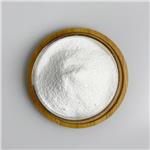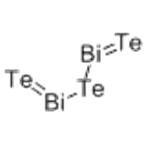Bismuth telluride is a gray crystalline solid.Molecular weight=800.83; Specific gravity (H2O:1)=7.7;Freezing/Melting point=573℃; Vapor pressure=0 mmHgat 20℃. Hazard Identification (based on NFPA-704 MRating System): Health 2, Flammability 2, Reactivity 2.Note: Commercial mix of doped bismuth tritelluride maycontain 80% Bi2Te3, 20% stannous telluride, plus some tellurium. Insoluble in water. Doped and undoped have similarphysical properties.
Bismuth telluride is a gray or black crystalline
solid or gray powder.
Bi2Te3, along with Sb2Te3 and other structurally analogous semiconductors, is widely regarded as one of the best materials for room-temperature thermoelectric devices. Bismuth(III) telluride is a key component of thermoelectric materials that have reached ZT values as high as 2.4 at room temperature.
Semiconductors; thermoelectric
cooling; power generation application; for
commercial use, Bi2Te3 is “doped” with selenium
sulfide to alter its conductivity.
In electronics as semiconductor.
Gray or black hexagonal platelets with a metallic luster or gray powder. Mp: 586°C. Density: 7.8 g cm-3. An alloy of two metallic elements.
BISMUTH TELLURIDE may emit toxic fumes of tellurium when heated to decomposition. Incompatible with strong oxidizing agents such as nitric acid or bromine, chlorine or fluorine. Moderate fire hazard by reaction with such materials. May react with strong acids to evolve toxic gases; may react slowly with water to evolve toxic gases. Slight explosion hazard with moisture.
Bismuth telluride, either alone
or doped with selenium sulfide, is apparently of
very low toxicity.
In limited industrial experimental work
with bismuth telluride under controlled conditions
(vacuum hoods), no adverse health
effects were encountered other than tellurium
breath.
Bismuth telluride is used in thermoelectric
cooling, power generation, semiconductor manufacture;
pharmaceuticals; medical therapy; cosmetics.
Exposure involves those working in “Silicon Valley” and
similar locations around the world. An alloy of two metallic
elements that are sometimes doped with SeS. The SeS
dopant alters the electrical properties, but has too low a
concentration to affect the chemical properties.
If this chemical gets into the eyes, remove anycontact lenses at once and irrigate immediately for at least15 min, occasionally lifting upper and lower lids. Seekmedical attention immediately. If this chemical contactsthe skin, remove contaminated clothing and wash immediately with soap and water. Seek medical attention immediately.If this chemical has been inhaled, remove fromexposure, begin rescue breathing (using universal precautions, including resuscitation mask) if breathing hasstopped and CPR if heart action has stopped. Transferpromptly to a medical facility. When this chemical hasbeen swallowed, get medical attention. Give large quantities of water and induce vomiting. Do not make anunconscious person vomit.Note to physician: For severe poisoning BAL [BritishAnti-Lewisite, dimercaprol, dithiopropanol (C3H8OS2)] hasbeen used to treat toxic symptoms of certain heavy metalspoisoning. In the case of bismuth poisoning it may haveSOME value. Although BAL is reported to have a largemargin of safety, caution must be exercised, because toxiceffects may be caused by excessive dosage. Most can beprevented by premedication with 1-ephedrine sulfate(CAS: 134-72-5).
Color Code—Blue: Health Hazard/Poison: Storein a secure poison location. Bismuth telluride must bestored to avoid contact with strong oxidizers (such as chlorine, bromine, and fluoride), since violent reactions occur.Store in tightly closed containers in a cool, well-ventilatedarea away from moisture.
UN3284 Tellurium compound, n.o.s., Hazard
Class: 6.1; Labels: 6.1—Poisonous materials, Technical
Name Required.
Reacts with acids forming toxic gases.
Incompatible with oxidizers (chlorates, nitrates, peroxides,
permanganates, perchlorates, chlorine, bromine, fluorine,
etc.); contact may cause fires or explosions. Keep away
from alkaline materials, strong bases, strong acids, oxoacids,
epoxides. Toxic and flammable gas may slowly
evolve from contact with moisture.



